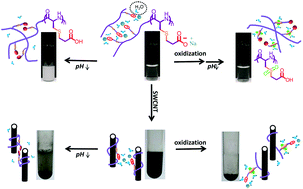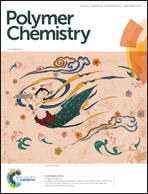A pH and redox dual responsive homopolypeptide: synthesis, characterization, and application in “smart” single-walled carbon nanotube dispersion†
Abstract
A homopolypeptide, namely poly(S-(2-carboxylethyl)-L-cysteine) (PCELC), with pH and redox dual responsiveness was prepared by ring-opening polymerization of S-(2-(methoxycarbonyl)ethyl)-L-cysteine based N-carboxyanhydride (MCELC-NCA) and subsequent hydrolysis. The pH-induced solution phase transition of PCELC was at pH = ∼4.50 as revealed by DLS and UV-vis spectroscopy. The thioether linkages of PCELC can be readily oxidized by H2O2 at 40 °C yielding PCELCox with sulfoxide and sulfone linkages as revealed by 1H NMR and FTIR. PCELCox also showed pH responsiveness with the variation of polymer aggregation sizes, but without solution phase separation. PCELCox can be partially reduced by 3-mercaptopropionic acid as suggested by 1H NMR and FTIR analysis. The pH-induced solution phase transition behavior of the reduction product (i.e., PCELCre) was different from that of the as-prepared PCELC. Moreover, PCELC can be used as a pH and oxidation dual responsive stabilizer to control the aggregation of single-walled carbon nanotubes (SWCNTs) in aqueous solution.



 Please wait while we load your content...
Please wait while we load your content...